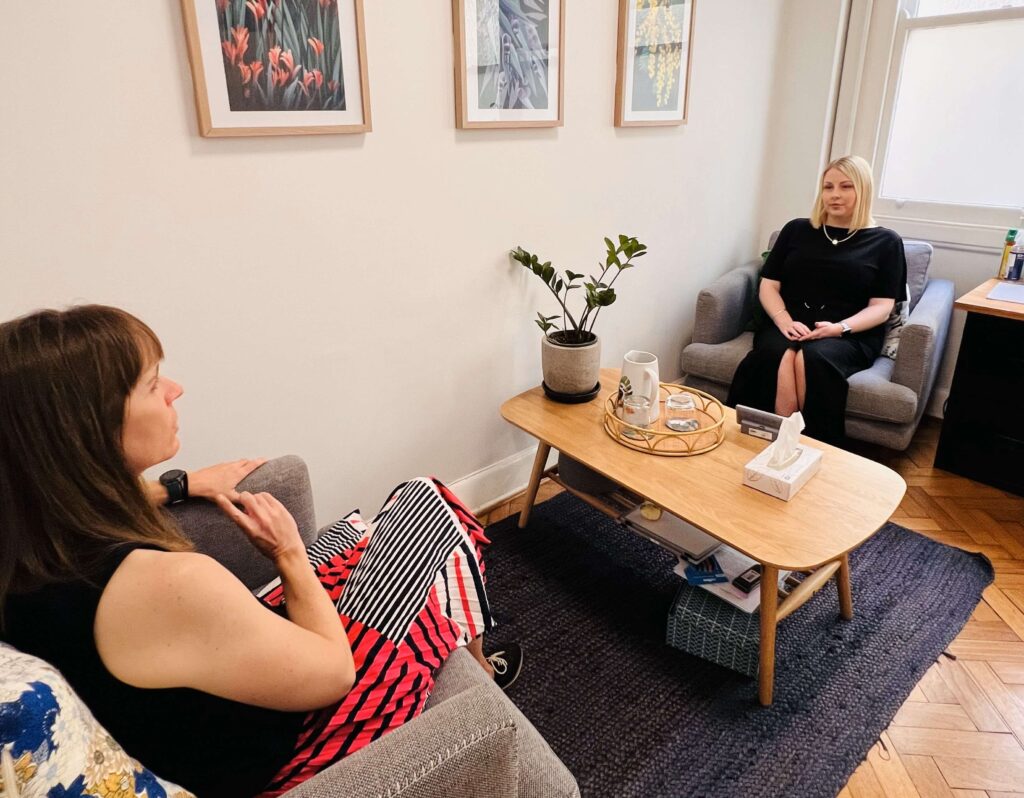Dealing with anxiety on your own can be challenging, but finding the right treatment for anxiety treatment doesn’t have to be. In today’s blog, we explore how to identify and understand a range of anxiety disorders, as well as provide a straightforward look at effective treatments and strategies for managing anxiety.
Key Takeaways
Anxiety disorders can severely disrupt our daily functioning and can require multifaceted treatment approaches, including Cognitive Behavioural Therapy and medications, with treatments often tailored to individual and specific disorders.
Lifestyle changes and complementary therapies can augment clinical anxiety treatments, with strategies ranging from physical activity and stress management to nutrition and mindfulness practices.
Addressing co-existing conditions such as depression, alongside the actual anxiety, can be an important step, employing a highly individualised treatment plan and integrated approaches for effective management.
Table of Contents
Understanding Anxiety Disorders
Anxiety disorders are far more significant than most people’s daily worries, and instead, can profoundly interfere with one’s routine life, well being, and overall mental health. These disorders are shaped by a mix of genetic factors, environmental influences, psychological dynamics, and developmental aspects. Common anxiety disorders include, Generalised Anxiety Disorder (GAD), Panic Disorder, Obsessive Compulsive Disorder (OCD) and Social Anxiety Disorder.
Recognising Anxiety Symptoms: Mental, Physical, and Behavioural
Anxiety disorders can influence our thoughts, bodily health and actions. Mental or cognitive symptoms of anxiety can consist of:
Constant worrying
Ruminative thought patterns
Worrying about the future and what will happen next
Worrying about the past and what has transpired
Unable to let go of worry thoughts
“Catastrophising” (imagining the worst case scenario will actually transpire)
Worrying about how you are being perceived by others
Constant worries about your own performance
Persistent obsessions
Repetitive mental rituals
Distressing dreams or recollections
These mental effects frequently culminate in perpetual vigilance, causing the person to feel permanently on guard and incapable of unwinding.
An anxiety disorder can also have a significant impact on one’s body and physical well-being. Individuals might experience symptoms including:
Excessive sweating
Physical tension
Tightness in body and chest
Elevated breathing rate
Elevated heart rate
Panic attacks
A panic attack is a symptom of a type of anxiety disorder called Panic Disorder. It is a sudden and intense surge of overwhelming fear and anxiety. This experience is characterised by a rapid heartbeat, shortness of breath, dizziness, trembling, and a powerful sense of impending doom or loss of control.
During a panic attack, individuals may also experience chest pain, sweating, nausea, and a feeling of detachment from reality or themselves. These episodes can be highly frightening and can mimic the symptoms of a heart attack, but they are not life-threatening. Panic and anxiety attacks typically peak within minutes and can leave the person feeling exhausted or stressed long after the attack has subsided.
Anxiety disorders are characterised by a range of behavioural changes that can significantly impact an individual’s daily functioning. These changes may include avoidance of certain situations or places that trigger anxiety, a noticeable decrease in participation in activities once enjoyed, and social withdrawal as a means to cope with overwhelming feelings of nervousness. Individuals may also exhibit increased irritability, difficulty concentrating, and restlessness.
For some people, anxiety can lead to the development of specific rituals or routines that are performed in an attempt to alleviate distress or prevent feared events, as seen in conditions like Obsessive-Compulsive Disorder (OCD). These behavioural alterations are often disruptive and can interfere with personal relationships, work responsibilities, and overall quality of life.
The Impact of Anxiety on Daily Living
Anxiety disorders have the potential to deeply interfere with one’s everyday life. They are often accompanied by chronic tiredness and a lack of sleep, which can undermine job performance through diminished productivity, a weakened ability to concentrate, and challenges in decision-making. These issues may spill over into professional relationships, causing an increase in social anxiety during work-related gatherings and prompting self-doubt regarding abilities or performance.
Outside the workplace, anxiety can strain relationships by promoting avoidance behaviours and emotional detachment. Anxiety may impede on forming trustful connections as well as decrease an individual’s openness to new experiences, which can lower quality of life and wellbeing. Anxiety can also contribute to withdrawal from social scenes because individuals experiencing anxiety might hesitate to form new connections or sustain existing friendships – as isolation increases, so too can anxiety symptoms.

Comprehensive Treatment for Anxiety Disorders
Treatment of anxiety disorders typically comprises psychological approaches, though can involve pharmacological interventions under the guidance of a doctor. Psychological approaches include:
Utilising cognitive behavioural therapy (CBT) to change maladaptive thought patterns and beliefs.
Shifting unhelpful behaviours such as avoidance, for example starting to engage with situations that trigger anxiety.
Increasing emotion regulation skills to assist in managing the physical sensations of anxiety.
Using controlled breathing and relaxation strategies to promote feelings of calm.
Using mindfulness to remain present rather than being caught up in anxious thoughts.
Cognitive Behavioural Therapy (CBT)
Cognitive behavioural therapy, commonly known as CBT, is a widely used form of treatment for a range of anxiety disorders due to its strong evidence base. The foundational concept of CBT posits that our thoughts significantly influence our emotions and behaviours. This approach underlines that an individual’s mental framework greatly affects emotional health. Consequently, the primary objective of CBT is to pinpoint and modify unhelpful thought patterns along with misconceptions about oneself and one’s environment.
To facilitate this process, cognitive behavioural therapy integrates cognitive techniques with behaviour change techniques like exposure activities which enable patients to adjust both their thoughts and behaviours in tandem.
Challenging Anxious Thoughts with CBT Techniques
Cognitive Behavioural Therapy (CBT) offers a variety of techniques to challenge and change anxious thoughts that contribute to anxiety disorders. One core technique is cognitive restructuring, which involves identifying negative, irrational thought patterns and questioning their validity. By examining the evidence for and against these thoughts, individuals can develop a more balanced perspective. For instance, if you often find yourself assuming the worst outcome, CBT encourages you to consider other, more likely outcomes. Another technique is the use of thought records, where you document anxious thoughts and look for cognitive distortions, such as catastrophizing or overgeneralizing. By recognizing these patterns, you can begin to replace them with more realistic and positive thoughts.
Behavioural Changes Through CBT in Anxiety Treatment
Cognitive Behavioural Therapy (CBT) is instrumental in facilitating behavioural changes during the treatment of anxiety. This structured, time-limited therapy approach focuses on teaching individuals to recognize and alter the thought patterns that contribute to their anxious feelings and behaviours. CBT employs various strategies such as exposure therapy, where individuals are gradually and systematically exposed to the situations or objects they fear, in a controlled and safe environment. This exposure helps to reduce the fear response over time. Additionally, CBT encourages the development of coping skills, enabling individuals to confront anxiety-inducing situations rather than avoiding them, which can perpetuate the cycle of anxiety. By practicing these new behaviours in real-life scenarios, patients learn to manage their anxiety more effectively and regain control over their actions, leading to improved functioning and quality of life.
Specialized Therapies for Specific Anxiety Disorders
Treatment for Panic Disorder
Panic disorder is a type of anxiety disorder characterised by recurrent and unexpected panic attacks. These attacks are intense periods of fear or intense discomfort, that develop abruptly and reach a peak within minutes. Symptoms during a panic attack can include heart palpitations, sweating, trembling, shortness of breath, and feelings of impending doom. Research has demonstrated that panic disorder can be effectively treated with psychological intervention. Studies have shown that cognitive behavioural therapy (CBT) outperforms both no intervention and placebo controls in the effective management of panic disorder, notably diminishing the occurrence of panic attacks. Clients of this therapy can learn how to take control of panic attacks and over time, avoid them from occurring.
Cognitive Behavioural Therapy (CBT) takes a two-pronged approach when addressing panic disorder by targeting both the physical symptoms and the behavioural patterns associated with anxiety. CBT techniques help individuals recognize the onset of physical symptoms—such as heart palpitations, shortness of breath, and dizziness—commonly experienced during panic attacks. Through methods like controlled breathing and muscle relaxation, patients learn to calm their physiological responses. Simultaneously, CBT aids in reshaping behaviour by breaking the cycle of avoidance and fear. By gradually exposing patients to feared situations in a controlled environment, CBT encourages the development of coping strategies that reduce the frequency and intensity of panic attacks, thereby modifying the individual’s behaviour over time and reducing overall anxiety.
Tackling Social Anxiety Disorder
Social Anxiety Disorder, also known as social phobia, is a mental health condition characterised by an intense, persistent fear of being judged by others. This fear can affect work, school, and other day-to-day activities, and it may cause individuals to avoid situations where they might be the centre of attention.
By taking on feared social situations incrementally and readying oneself for social encounters, individuals can effectively manage Social Anxiety Disorder. Within a CBT framework this occurs through the use of an exposure hierarchy. An exposure hierarchy involves creating a structured list of social situations that provoke anxiety, arranged from the least to the most distressing. The individual and therapist collaborate to gradually expose the person to these scenarios, starting with the least anxiety-inducing and progressively moving up the hierarchy. This controlled, step-by-step approach allows the individual to confront their fears in a manageable way, building confidence and resilience as they learn that the expected negative outcomes are often not as severe as anticipated. Over time, this method helps to desensitise the person to social situations that once triggered significant anxiety, ultimately aiming to reduce the overall frequency and intensity of their anxious responses.
Managing Generalised Anxiety Disorder
Generalised Anxiety Disorder (GAD) is a mental health condition characterised by excessive and persistent worry about various aspects of daily life, often to the point where it interferes with one’s ability to function. A CBT treatment for GAD includes:
Cognitive strategies designed to manage excessive worrying thoughts . These include reassessing overstated risks and pinpointing and managing catastrophic thinking.
Regulating sleep patterns
Relaxation and grounding techniques to manage the physical symptoms of anxiety
Mindfulness strategies to move the mind away from worry and instead to being in the present moment.
Behavioural strategies to include strengthening self-care and pleasurable activities.
Treatment for Obsessive-Compulsive Disorder (OCD)
Obsessive-Compulsive Disorder (OCD) is a chronic anxiety disorder characterised by recurrent, unwanted thoughts (obsessions) and repetitive behaviours (compulsions). Individuals with OCD engage in these behaviours in an attempt to reduce the anxiety caused by their obsessions or to prevent a feared event or situation, even though these actions are usually not realistically connected to the event they aim to prevent.
Psychologists often treat OCD using a combination of Cognitive Behavioural Therapy (CBT) and Exposure and Response Prevention (ERP). CBT helps patients understand the thoughts and feelings that influence their behaviours and teaches them to identify and challenge the irrational beliefs that fuel their obsessions.
ERP is a specific type of CBT that has been especially effective for treating OCD. It involves exposing the individual to the source of their anxiety or obsessional fears without allowing them to engage in their compulsive behaviours. Over time, this process can help reduce the compulsive need to perform these behaviours as individuals learn through experience that nothing harmful happens when they do not perform their rituals.
In addition to CBT and ERP, psychologists may also use other therapeutic approaches such as mindfulness-based cognitive therapy, which helps patients focus on the present moment and accept their thoughts without judgment. This can be particularly useful for managing the intrusive thoughts associated with OCD.
Integrating Lifestyle Changes and Complementary Therapies
Incorporating changes in daily habits and alternative therapies can play an important role in managing anxiety. These methods include:
Improving sleep patterns
Participating in regular exercise
Practicing mindfulness and deep breathing techniques
Trying activities like yoga, relaxation training, or engaging with acupuncture
These supplementary approaches may help relieve the symptoms of anxiety either as standalone remedies or when used together with conventional psychological treatments.
Stress Management and Relaxation Skills
Incorporating relaxation techniques such as progressive muscle relaxation and mindfulness meditation can play a role in mitigating anxiety and bolstering emotional health.
To alleviate stress effectively, consider engaging in activities like:
Engaging with music either through listening or playing
Use your 5 senses to soothe you. Tune into your senses with stimuli that is calming and relaxing.
Exercising to burn off nervous energy
Mindful stretching techniques
Engaging in a creative activity at home whether that be decorating, a craft activity, or cooking.
Be in nature.
Finding reasons to laugh (watch films, comedy, be around people who make you laugh!)
Adopting yoga practices
Ensuring you get enough rest
Ensuring you take a break from screens and social media.
These endeavours not only divert the mind, but also elicit physical changes that help combat tension. Yoga uniquely merges bodily poses with breath control exercises, promoting both mental and physical calmness. Adequate sleep is essential too. It provides the brain and body time to rejuvenate, which aids in coping with life’s pressures.


Managing your Thinking
Handling the physical symptoms of anxiety is equally as vital as controlling your thought processes when it comes to treating anxiety. Employing techniques like cognitive challenging and mindfulness is beneficial in regulating detrimental anxious thoughts, interrupting the spiral of worry, and nurturing psychological health.
Cognitive challenging – a technique that involves identifying and questioning or challenging negative thoughts or unhelpful thoughts can be very effective when you notice worry thoughts coming on. This might mean that you shift your thinking from the worry thought to a more helpful way of thinking, for example “well, that hasn’t happened at this stage, and I don’t have any evidence that it will, so I’m letting go of this worry.” Mindfulness complements this by helping individuals let go of disruptive thoughts, focusing on the present. When you recognise an unhelpful thought, mindfulness teaches us to notice it, then let it go and return to whatever you can tune into in the here and now.
Exercise and Mindfulness
Incorporating physical exercise and mindfulness routines can effectively combat anxiety. Here’s how they contribute:
Physical activity boosts mood through the release of endorphins, which are the body’s natural feel-good chemicals.
Engaging in regular workouts can serve as an active form of meditation, increasing relaxation and reducing stress levels.
Mindfulness exercises like meditation help teach the brain to stay focused on the present moment, thereby decreasing constant concerns about what has passed or what is yet to come—common issues for those dealing with anxiety.
When you combine consistent exercise with mindful practices regularly, these strategies can reduce anxiety and lead to overall mental health benefits. Techniques geared towards relaxation such as deep breathing exercises, practicing mindfulness meditation, and employing guided imagery not only assist in managing day-to-day stress but also can be used to improve sleep quality.
Finding the Right Help: Counselling in Melbourne
In Melbourne, expert services for the treatment of anxiety are available through therapists including psychologists, clinical psychologists, and mental health accredited social workers.
Therapy may be delivered through one-on-one therapy sessions, or though group therapy sessions where skills are delivered weekly in a group setting.
Choosing a Therapist
When selecting a psychologist to address anxiety issues, we recommend ensuring your therapist has experience in treating your anxiety problems and choosing someone whom you’re likely to form a good therapeutic relationship with. The therapeutic relationship has considerable influence on the effectiveness of those treating anxiety disorders, which underscores the importance of ensuring that both parties are well-matched.
In Melbourne, to find an appropriate clinical psychologist can be found by:
Exploring different therapist options online through search engines such as Google.
Finding a psychologist through the Australian Psychological Society’s “Find a Psychologist” search engine.
Seeking a referral through your general practitioner or psychiatrist.
Summary
Anxiety disorders are complex and multi-faceted, and can be effectively managed with the right understanding and treatment approach. From recognising symptoms to understanding their impact on daily life, and exploring different treatment options, the journey to overcome anxiety can be empowering. The integration of lifestyle changes, complementary therapies, and consistent self-care further enhances the effectiveness of clinical treatments.
Frequently Asked Questions
What is the 3 3 3 rule for anxiety?
The 3 3 3 rule is an easily-implemented method to regain composure and find your grounding amidst bouts of anxiety. It requires you to acknowledge three items in your sight, identify three sounds in your environment, and engage three distinct parts of the body through movement.
This approach has proven beneficial for a multitude of individuals seeking to cope with anxious feelings.
What is the best way to treat anxiety disorders?
To effectively manage anxiety, it is essential to understand your emotional and cognitive patterns and to work on these. This can be done within the context of psychological treatment where your anxiety disorder is treated by a therapist. Treatment strategies such as CBT help to identify and shift unhelpful thought patterns and behaviours. Modifying one’s breathing patterns, maintaining a regular exercise regimen, and ensuring strong self-care are also helpful components of anxiety management.
What causes anxiety in the brain?
It is thought that the amygdala, which resembles an almond in shape and is located deep within the brain, serves as a central station for signalling anxiety. It has the capability to initiate a reaction of fear or anxiety by notifying other parts of the brain about an imminent danger.
It’s believed that imbalances in activity levels within the emotional regions of the brain—as opposed to those occurring within higher cognitive areas—are influential factors leading to mood and anxiety disorders.
What are some common symptoms of anxiety disorders?
Anxiety disorders are often characterised by feelings of restlessness, persistent worry, fearfulness, and intrusive or negative thoughts. Physical signs such as sweating and experiencing panic attacks are also common symptoms associated with anxiety that can profoundly affect everyday activities.















